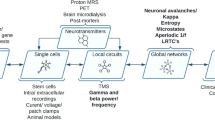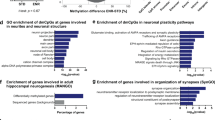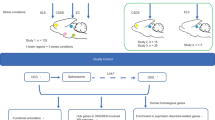Abstract
Physical–cognitive activity has long-lasting beneficial effects on the brain and on behavior. Environmental enrichment (EE) induces brain activity known to influence the behavior of mice, as measured in learned helplessness paradigms (forced swim test), and neurogenic cell populations in the hippocampal dentate gyrus. However, it is not completely clear whether the antidepressant and proneurogenic effects of EE are different in animals that are naive or pre-exposed to the stress inducing helplessness, and if this depends on the type of stressor. It also remains unclear whether differential effects are exerted on distinct neurogenic subpopulations. We found that EE has a protective effect in adult female mice (C57BL/6J) when exposed twice to the same stressor (forced swim test) but it has no influence on recovery. The repeated exposure to this stressor was analyzed together with the effects of EE on different neurogenic populations distinguished by age and differentiation state. Younger cells are more sensitive and responsive to the conditions, both the positive and negative effects. These results are relevant to identify the cell populations that are the targets of stress, depression, and enrichment, and that form part of the mechanism responsible for mood dysfunctions.
Similar content being viewed by others
Log in or create a free account to read this content
Gain free access to this article, as well as selected content from this journal and more on nature.com
or
References
Armario A, Gavalda A, Marti O (1988). Forced swimming test in rats: effect of desipramine administration and the period of exposure to the test on struggling behavior, swimming, immobility and defecation rate. Eur J Pharmacol 158: 207–212.
Borsini F, Lecci A, Sessarego A, Frassine R, Meli A (1989). Discovery of antidepressant activity by forced swimming test may depend on pre-exposure of rats to a stressful situation. Psychopharmacology (Berl) 97: 183–188.
Cordoba F, Yusta B, Munoz-Blanco J (1984). Changes in neurotransmitter amino acids and protein in CNS areas of mice subjected to differential housing conditions. Pharmacol Biochem Behav 21: 349–352.
Chourbaji S, Brandwein C, Vogt MA, Dormann C, Hellweg R, Gass P (2008). Nature vs. nurture: can enrichment rescue the behavioural phenotype of BDNF heterozygous mice? Behav Brain Res 192: 254–258.
Christie BR, Eadie BD, Kannangara TS, Robillard JM, Shin J, Titterness AK (2008). Exercising our brains: how physical activity impacts synaptic plasticity in the dentate gyrus. Neuromolecular Med 10: 47–58.
Detke MJ, Rickels M, Lucki I (1995). Active behaviors in the rat forced swimming test differentially produced by serotonergic and noradrenergic antidepressants. Psychopharmacology (Berl) 121: 66–72.
Dupret D, Revest JM, Koehl M, Ichas F, De Giorgi F, Costet P et al (2008). Spatial relational memory requires hippocampal adult neurogenesis. PLoS One 3: e1959.
Fox C, Merali Z, Harrison C (2006). Therapeutic and protective effect of environmental enrichment against psychogenic and neurogenic stress. Behav Brain Res 175: 1–8.
García-Segura LM (2009). Hormones and Brain Plasticity. Oxford University Press: Oxford.
Greer TL, Trivedi MH (2009). Exercise in the treatment of depression. Curr Psychiatry Rep 11: 466–472.
Hilakivi LA, Durcan MJ, Lister RG (1989). Effects of ethanol on fight- or swim-stressed mice in Porsolt's swim test. Neuropsychopharmacology 2: 293–298.
Hutchinson E, Avery A, Vandewoude S (2005). Environmental enrichment for laboratory rodents. ILAR J 46: 148–161.
Kempermann G (2008). The neurogenic reserve hypothesis: what is adult hippocampal neurogenesis good for? Trends Neurosci 31: 163–169.
Kempermann G, Kuhn HG, Gage FH (1997a). Genetic influence on neurogenesis in the dentate gyrus of adult mice. Proc Natl Acad Sci USA 94: 10409–10414.
Kempermann G, Kuhn HG, Gage FH (1997b). More hippocampal neurons in adult mice living in an enriched environment. Nature 386: 493–495.
Kempermann G, Kuhn HG, Gage FH (1998). Experience-induced neurogenesis in the senescent dentate gyrus. J Neurosci 18: 3206–3212.
Komitova M, Mattsson B, Johansson BB, Eriksson PS (2005). Enriched environment increases neural stem/progenitor cell proliferation and neurogenesis in the subventricular zone of stroke-lesioned adult rats. Stroke 36: 1278–1282.
Laviola G, Hannan AJ, Macri S, Solinas M, Jaber M (2008). Effects of enriched environment on animal models of neurodegenerative diseases and psychiatric disorders. Neurobiol Dis 31: 159–168.
Leal-Galicia P, Saldivar-Gonzalez A, Morimoto S, Arias C (2007). Exposure to environmental enrichment elicits differential hippocampal cell proliferation: role of individual responsiveness to anxiety. Dev Neurobiol 67: 395–405.
Leuner B, Glasper ER, Gould E (2009). Thymidine analog methods for studies of adult neurogenesis are not equally sensitive. J Comp Neurol 517: 123–133.
Llorens-Martin M, Torres-Aleman I, Trejo JL (2006). Pronounced individual variation in the response to the stimulatory action of exercise on immature hippocampal neurons. Hippocampus 16: 480–490.
Llorens-Martin M, Torres-Aleman I, Trejo JL (2009). Mechanisms mediating brain plasticity: IGF1 and adult hippocampal neurogenesis. Neuroscientist 15: 134–148.
Llorens-Martin MV, Rueda N, Martinez-Cue C, Torres-Aleman I, Florez J, Trejo JL (2007). Both increases in immature dentate neuron number and decreases of immobility time in the forced swim test occurred in parallel after environmental enrichment of mice. Neuroscience 147: 631–638.
Llorens-Martin M, Tejeda GS, Trejo JL (2010). Differential regulation of the variations induced by environmental richness in adult neurogenesis as a function of time. A dual birthdating analysis. PLoS One 5: e12188.
Mandolesi L, De Bartolo P, Foti F, Gelfo F, Federico F, Leggio MG et al (2008). Environmental enrichment provides a cognitive reserve to be spent in the case of brain lesion. J Alzheimers Dis 15: 11–28.
Martinez-Cue C, Baamonde C, Lumbreras M, Paz J, Davisson MT, Schmidt C et al (2002). Differential effects of environmental enrichment on behavior and learning of male and female Ts65Dn mice, a model for Down syndrome. Behav Brain Res 134: 185–200.
Meshi D, Drew MR, Saxe M, Ansorge MS, David D, Santarelli L et al (2006). Hippocampal neurogenesis is not required for behavioral effects of environmental enrichment. Nat Neurosci 9: 729–731.
Milgram NW, Siwak-Tapp CT, Araujo J, Head E (2006). Neuroprotective effects of cognitive enrichment. Ageing Res Rev 5: 354–369.
Mora F, Segovia G, del Arco A (2007). Aging, plasticity and environmental enrichment: structural changes and neurotransmitter dynamics in several areas of the brain. Brain Res Rev 55: 78–88.
Murison R, Overmier JB, Skoglund EJ (1986). Serial stressors: prior exposure to a stressor modulates its later effectiveness on gastric ulceration and corticosterone release. Behav Neural Biol 45: 185–195.
Navailles S, Hof PR, Schmauss C (2008). Antidepressant drug-induced stimulation of mouse hippocampal neurogenesis is age-dependent and altered by early life stress. J Comp Neurol 509: 372–381.
Nithianantharajah J, Hannan AJ (2009). The neurobiology of brain and cognitive reserve: mental and physical activity as modulators of brain disorders. Prog Neurobiol 89: 369–382.
Olson AK, Eadie BD, Ernst C, Christie BR (2006). Environmental enrichment and voluntary exercise massively increase neurogenesis in the adult hippocampus via dissociable pathways. Hippocampus 16: 250–260.
Petrosini L, De Bartolo P, Foti F, Gelfo F, Cutuli D, Leggio MG et al (2009). On whether the environmental enrichment may provide cognitive and brain reserves. Brain Res Rev 61: 221–239.
Porsolt RD, Anton G, Blavet N, Jalfre M (1978). Behavioural despair in rats: a new model sensitive to antidepressant treatments. Eur J Pharmacol 47: 379–391.
Porsolt RD, Bertin A, Jalfre M (1977a). Behavioral despair in mice: a primary screening test for antidepressants. Arch Int Pharmacodyn Ther 229: 327–336.
Porsolt RD, Le Pichon M, Jalfre M (1977b). Depression: a new animal model sensitive to antidepressant treatments. Nature 266: 730–732.
Rau V, DeCola JP, Fanselow MS (2005). Stress-induced enhancement of fear learning: an animal model of posttraumatic stress disorder. Neurosci Biobehav Rev 29: 1207–1223.
Rau V, Fanselow MS (2009). Exposure to a stressor produces a long lasting enhancement of fear learning in rats. Stress 12: 125–133.
Sabban EL, Serova LI (2007). Influence of prior experience with homotypic or heterotypic stressor on stress reactivity in catecholaminergic systems. Stress 10: 137–143.
Sale A, Berardi N, Maffei L (2009). Enrich the environment to empower the brain. Trends Neurosci 32: 233–239.
Schaeffer EL, Novaes BA, da Silva ER, Skaf HD, Mendes-Neto AG (2009). Strategies to promote differentiation of newborn neurons into mature functional cells in Alzheimer brain. Prog Neuropsychopharmacol Biol Psychiatry 33: 1087–1102.
Schloesser RJ, Lehmann M, Martinowich K, Manji HK, Herkenham M (2010). Environmental enrichment requires adult neurogenesis to facilitate the recovery from psychosocial stress. Mol Psychiatry 15: 1152–1163.
Segovia G, Yague AG, Garcia-Verdugo JM, Mora F (2006). Environmental enrichment promotes neurogenesis and changes the extracellular concentrations of glutamate and GABA in the hippocampus of aged rats. Brain Res Bull 70: 8–14.
Sibille E, Sarnyai Z, Benjamin D, Gal J, Baker H, Toth M (1997). Antisense inhibition of 5-hydroxytryptamine2a receptor induces an antidepressant-like effect in mice. Mol Pharmacol 52: 1056–1063.
Stead JD, Clinton S, Neal C, Schneider J, Jama A, Miller S et al (2006). Selective breeding for divergence in novelty-seeking traits: heritability and enrichment in spontaneous anxiety-related behaviors. Behav Genet 36: 697–712.
Sztainberg Y, Kuperman Y, Tsoory M, Lebow M, Chen A (2010). The anxiolytic effect of environmental enrichment is mediated via amygdalar CRF receptor type 1. Mol Psychiatry 15: 905–917.
Trejo JL, Llorens-Martin MV, Torres-Aleman I (2008). The effects of exercise on spatial learning and anxiety-like behavior are mediated by an IGF-I-dependent mechanism related to hippocampal neurogenesis. Mol Cell Neurosci 37: 402–411.
Trejo JL, Piriz J, Llorens-Martin MV, Fernandez AM, Bolos M, LeRoith D et al (2007). Central actions of liver-derived insulin-like growth factor I underlying its pro-cognitive effects. Mol Psychiatry 12: 1118–1128.
van Praag H, Kempermann G, Gage FH (1999). Running increases cell proliferation and neurogenesis in the adult mouse dentate gyrus. Nat Neurosci 2: 266–270.
Acknowledgements
We thank Belén García and Carmen Hernández for their help with the confocal microscopy, and Laude Garmendia for her help with the animals at the Cajal Institute. We also appreciate the assistance of Dr Mark Sefton in revising the manuscript. Grant awarded to JLT from the Ministerio de Educacion y Ciencia. Grant number: BFU2007-60195/BFI. The funders had no role in study design, data collection and analysis, decision to publish, or preparation of the manuscript.
Author information
Authors and Affiliations
Corresponding author
Ethics declarations
Competing interests
The authors declare that, except for income received from the primary employer, no financial support or compensation has been received from any individual or corporate entity over the past 3 years for research or professional service and there are no personal financial holdings that could be perceived as constituting a potential conflict of interest.
Rights and permissions
About this article
Cite this article
Llorens-Martín, M., Tejeda, G. & Trejo, J. Antidepressant and Proneurogenic Influence of Environmental Enrichment in Mice: Protective Effects vs Recovery. Neuropsychopharmacol 36, 2460–2468 (2011). https://doi.org/10.1038/npp.2011.134
Received:
Revised:
Accepted:
Published:
Issue date:
DOI: https://doi.org/10.1038/npp.2011.134
Keywords
This article is cited by
-
Environmental Enrichment Differentially Activates Neural Circuits in FVB/N Mice, Inducing Social Interaction in Females but Agonistic Behavior in Males
Neurochemical Research (2022)
-
GABAergic deficits in absence of LPA1 receptor, associated anxiety-like and coping behaviors, and amelioration by interneuron precursor transplants into the dorsal hippocampus
Brain Structure and Function (2021)
-
Effects of experimental housing conditions on recovery of laboratory mice
Lab Animal (2015)



